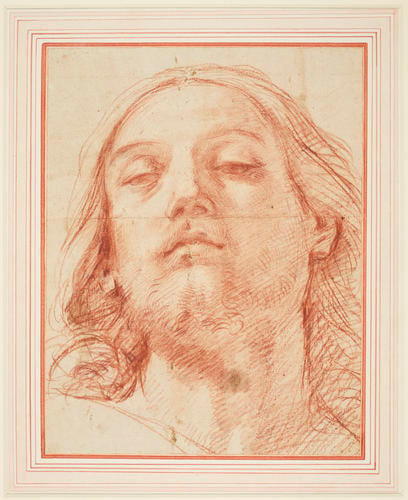-
1 of 253523 objects
The head of Christ, full face 1620
Red chalk | 34.4 x 26.7 cm (sheet of paper) | RCIN 905283

Guido Reni (Bologna 1575-Bologna 1642)
The head of Christ, full face 1620
-
A drawing of a male head, seen from below, looking downwards and to the left.
In 1620 Guido Reni provided his assistant Francesco Gessi with designs, including this sheet, for a painting of Christ the Saviour as the high altarpiece of Santissimo Salvatore, Bologna. The seventeenth-century biographer Malvasia recounted that Reni subsequently found out that his assistant had been slandering him, and so refused to pay Gessi for the work.
The drawing formed part of an album of fifty chalk heads by Reni’s Bolognese contemporary Giacomo Cavedone (RL 5244-93), and despite the differences of style and technique it has previously been catalogued by as by Cavedone. Catherine Johnston subsequently identified the sheet as a study by Guido Reni for the Salvator Mundi, painted to Reni’s designs by his assistant Francesco Gessi for the high altar of Santissimo Salvatore, Bologna. Payments to Reni for the painting are recorded between October and December 1620.
Though the connection with Gessi’s painting is not immediately striking, the identification is probably secure. The head is seen from below, though in the painting the effect of foreshortening is less strong and the gaze less imperious; the light falls from the same direction, and the edge of the Saviour’s cloak is delineated here by the stroke of chalk to lower left. Negro suggested that the drawing was also used by Gessi for a painting of the Saviour with a boy (private collection), though the tipped-back angle of the head is there even less marked.
Carlo Cesare Malvasia mentioned the painting three times. In his biographies of both Reni and Gessi in Felsina Pittrice (1678) he recounted that, because Gessi had been slandering Reni, the master refused him payment for works that Gessi had painted for Reni before their departure for Naples in 1621, including the Saviour for Santissimo Salvatore; and in his later Pitture di Bologna (1686) Malvasia explicitly mentioned the ‘disegno, pastello della testa’ by Guido from which Gessi had executed the painting. Malvasia probably knew the drawing at first hand, for it is to be identified with the ‘Dissegno con Testa del Salvatore mano di Guido in cornice dorata, e vetro’ listed in the 1696 Bonfiglioli inventory elsewhere Malvasia described as in the Bonfiglioli collection other drawings that are now at in the Royal Collection.
A drawing in the Victoria and Albert Museum, of a bearded head in red and black chalks, has been mentioned in relation to the painting, but the resemblance is no more than coincidental and the drawing appears closer in style to Cavedone than to Reni.
Catalogue entry adapted from The Art of Italy in the Royal Collection: Renaissance and Baroque, London, 2007Provenance
Silvestro Bonfiglioli; from whose heirs bought by Zaccaria Sagredo, 1728; from whom bought by Consul Joseph Smith, 1751-2; from whom bought by George III, 1762; first recorded in a Royal Collection inventory of c.1800-20 (Inv.A. p.84: as among 'Teste di Cavedone. Although slight yet Drawn with great Fire and Spirit, most as large as Life')
-
Creator(s)
Acquirer(s)
-
Medium and techniques
Red chalk
Measurements
34.4 x 26.7 cm (sheet of paper)
Object type(s)
Other number(s)
RL 5283